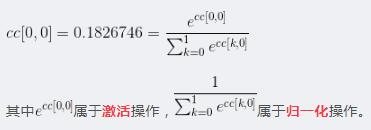- ubuntu12.04环境下使用kvm ioctl接口实现最简单的虚拟机
- Ubuntu 通过无线网络安装Ubuntu Server启动系统后连接无线网络的方法
- 在Ubuntu上搭建网桥的方法
- ubuntu 虚拟机上网方式及相关配置详解
CFSDN坚持开源创造价值,我们致力于搭建一个资源共享平台,让每一个IT人在这里找到属于你的精彩世界.
这篇CFSDN的博客文章关于tensorflow softmax函数用法解析由作者收集整理,如果你对这篇文章有兴趣,记得点赞哟.
如下所示:
|
1
2
3
4
5
6
7
8
9
10
11
12
13
14
15
16
17
18
19
20
21
|
def
softmax(logits, axis
=
None
, name
=
None
, dim
=
None
):
"""Computes softmax activations.
This function performs the equivalent of
softmax = tf.exp(logits) / tf.reduce_sum(tf.exp(logits), axis)
Args:
logits: A non-empty `Tensor`. Must be one of the following types: `half`,
`float32`, `float64`.
axis: The dimension softmax would be performed on. The default is -1 which
indicates the last dimension.
name: A name for the operation (optional).
dim: Deprecated alias for `axis`.
Returns:
A `Tensor`. Has the same type and shape as `logits`.
Raises:
InvalidArgumentError: if `logits` is empty or `axis` is beyond the last
dimension of `logits`.
"""
axis
=
deprecation.deprecated_argument_lookup(
"axis"
, axis,
"dim"
, dim)
if
axis
is
None
:
axis
=
-
1
return
_softmax(logits, gen_nn_ops.softmax, axis, name)
|
softmax函数的返回结果和输入的tensor有相同的shape,既然没有改变tensor的形状,那么softmax究竟对tensor做了什么?
答案就是softmax会以某一个轴的下标为索引,对这一轴上其他维度的值进行 激活 + 归一化处理.
一般来说,这个索引轴都是表示类别的那个维度(tf.nn.softmax中默认为axis=-1,也就是最后一个维度) 。
举例:
|
1
2
3
4
5
6
7
8
9
10
11
12
13
14
15
16
17
18
19
20
21
22
23
24
25
26
27
28
29
30
31
32
33
34
35
36
37
38
39
40
41
42
43
44
45
46
47
48
|
def
softmax(X, theta
=
1.0
, axis
=
None
):
"""
Compute the softmax of each element along an axis of X.
Parameters
----------
X: ND-Array. Probably should be floats.
theta (optional): float parameter, used as a multiplier
prior to exponentiation. Default = 1.0
axis (optional): axis to compute values along. Default is the
first non-singleton axis.
Returns an array the same size as X. The result will sum to 1
along the specified axis.
"""
# make X at least 2d
y
=
np.atleast_2d(X)
# find axis
if
axis
is
None
:
axis
=
next
(j[
0
]
for
j
in
enumerate
(y.shape)
if
j[
1
] >
1
)
# multiply y against the theta parameter,
y
=
y
*
float
(theta)
# subtract the max for numerical stability
y
=
y
-
np.expand_dims(np.
max
(y, axis
=
axis), axis)
# exponentiate y
y
=
np.exp(y)
# take the sum along the specified axis
ax_sum
=
np.expand_dims(np.
sum
(y, axis
=
axis), axis)
# finally: divide elementwise
p
=
y
/
ax_sum
# flatten if X was 1D
if
len
(X.shape)
=
=
1
: p
=
p.flatten()
return
p
c
=
np.random.randn(
2
,
3
)
print
(c)
# 假设第0维是类别,一共有里两种类别
cc
=
softmax(c,axis
=
0
)
# 假设最后一维是类别,一共有3种类别
ccc
=
softmax(c,axis
=
-
1
)
print
(cc)
print
(ccc)
|
结果:
|
1
2
3
4
5
6
7
8
9
|
c:
[[
-
1.30022268
0.59127472
1.21384177
]
[
0.1981082
-
0.83686108
-
1.54785864
]]
cc:
[[
0.1826746
0.80661068
0.94057075
]
[
0.8173254
0.19338932
0.05942925
]]
ccc:
[[
0.0500392
0.33172426
0.61823654
]
[
0.65371718
0.23222472
0.1140581
]]
|
可以看到,对axis=0的轴做softmax时,输出结果在axis=0轴上和为1(eg: 0.1826746+0.8173254),同理在axis=1轴上做的话结果的axis=1轴和也为1(eg: 0.0500392+0.33172426+0.61823654).
这些值是怎么得到的呢?
以cc为例(沿着axis=0做softmax):

以ccc为例(沿着axis=1做softmax):

知道了计算方法,现在我们再来讨论一下这些值的实际意义:
cc[0,0]实际上表示这样一种概率: P( label = 0 | value = [-1.30022268 0.1981082] = c[*,0] ) = 0.1826746 。
cc[1,0]实际上表示这样一种概率: P( label = 1 | value = [-1.30022268 0.1981082] = c[*,0] ) = 0.8173254 。
ccc[0,0]实际上表示这样一种概率: P( label = 0 | value = [-1.30022268 0.59127472 1.21384177] = c[0]) = 0.0500392 。
ccc[0,1]实际上表示这样一种概率: P( label = 1 | value = [-1.30022268 0.59127472 1.21384177] = c[0]) = 0.33172426 。
ccc[0,2]实际上表示这样一种概率: P( label = 2 | value = [-1.30022268 0.59127472 1.21384177] = c[0]) = 0.61823654 。
将他们扩展到更多维的情况:假设c是一个[batch_size , timesteps, categories]的三维tensor 。
output = tf.nn.softmax(c,axis=-1) 。
那么 output[1, 2, 3] 则表示 P(label =3 | value = c[1,2] ) 。
以上这篇关于tensorflow softmax函数用法解析就是小编分享给大家的全部内容了,希望能给大家一个参考,也希望大家多多支持我.
原文链接:https://blog.csdn.net/zongza/article/details/88016668 。
最后此篇关于关于tensorflow softmax函数用法解析的文章就讲到这里了,如果你想了解更多关于关于tensorflow softmax函数用法解析的内容请搜索CFSDN的文章或继续浏览相关文章,希望大家以后支持我的博客! 。
我想将模型及其各自训练的权重从 tensorflow.js 转换为标准 tensorflow,但无法弄清楚如何做到这一点,tensorflow.js 的文档对此没有任何说明 我有一个 manifest
我有一个运行良好的 TF 模型,它是用 Python 和 TFlearn 构建的。有没有办法在另一个系统上运行这个模型而不安装 Tensorflow?它已经经过预训练,所以我只需要通过它运行数据。 我
当执行 tensorflow_model_server 二进制文件时,它需要一个模型名称命令行参数,model_name。 如何在训练期间指定模型名称,以便在运行 tensorflow_model_s
我一直在 R 中使用标准包进行生存分析。我知道如何在 TensorFlow 中处理分类问题,例如逻辑回归,但我很难将其映射到生存分析问题。在某种程度上,您有两个输出向量而不是一个输出向量(time_t
Torch7 has a library for generating Gaussian Kernels在一个固定的支持。 Tensorflow 中有什么可比的吗?我看到 these distribu
在Keras中我们可以简单的添加回调,如下所示: self.model.fit(X_train,y_train,callbacks=[Custom_callback]) 回调在doc中定义,但我找不到
我正在寻找一种在 tensorflow 中有条件打印节点的方法,使用下面的示例代码行,其中每 10 个循环计数,它应该在控制台中打印一些东西。但这对我不起作用。谁能建议? 谢谢,哈米德雷萨, epsi
我想使用 tensorflow object detection API 创建我自己的 .tfrecord 文件,并将它们用于训练。该记录将是原始数据集的子集,因此模型将仅检测特定类别。我不明白也无法
我在 TensorFlow 中训练了一个聊天机器人,想保存模型以便使用 TensorFlow.js 将其部署到 Web。我有以下内容 checkpoint = "./chatbot_weights.c
我最近开始学习 Tensorflow,特别是我想使用卷积神经网络进行图像分类。我一直在看官方仓库中的android demo,特别是这个例子:https://github.com/tensorflow
我目前正在研究单图像超分辨率,并且我设法卡住了现有的检查点文件并将其转换为 tensorflow lite。但是,使用 .tflite 文件执行推理时,对一张图像进行上采样所需的时间至少是使用 .ck
我注意到 tensorflow 的 api 中已经有批量标准化函数。我不明白的一件事是如何更改训练和测试之间的程序? 批量归一化在测试和训练期间的作用不同。具体来说,在训练期间使用固定的均值和方差。
我创建了一个模型,该模型将 Mobilenet V2 应用于 Google colab 中的卷积基础层。然后我使用这个命令转换它: path_to_h5 = working_dir + '/Tenso
代码取自:- http://adventuresinmachinelearning.com/python-tensorflow-tutorial/ import tensorflow as tf fr
好了,所以我准备在Tensorflow中运行 tf.nn.softmax_cross_entropy_with_logits() 函数。 据我了解,“logit”应该是概率的张量,每个对应于某个像素的
tensorflow 服务构建依赖于大型 tensorflow ;但我已经成功构建了 tensorflow。所以我想用它。我做这些事情:我更改了 tensorflow 服务 WORKSPACE(org
Tensoflow 嵌入层 ( https://www.tensorflow.org/api_docs/python/tf/keras/layers/Embedding ) 易于使用, 并且有大量的文
我正在尝试使用非常大的数据集(比我的内存大得多)训练 Tensorflow 模型。 为了充分利用所有可用的训练数据,我正在考虑将它们分成几个小的“分片”,并一次在一个分片上进行训练。 经过一番研究,我
根据 Sutton 的书 - Reinforcement Learning: An Introduction,网络权重的更新方程为: 其中 et 是资格轨迹。 这类似于带有额外 et 的梯度下降更新。
如何根据条件选择执行图表的一部分? 我的网络有一部分只有在 feed_dict 中提供占位符值时才会执行.如果未提供该值,则采用备用路径。我该如何使用 tensorflow 来实现它? 以下是我的代码

我是一名优秀的程序员,十分优秀!